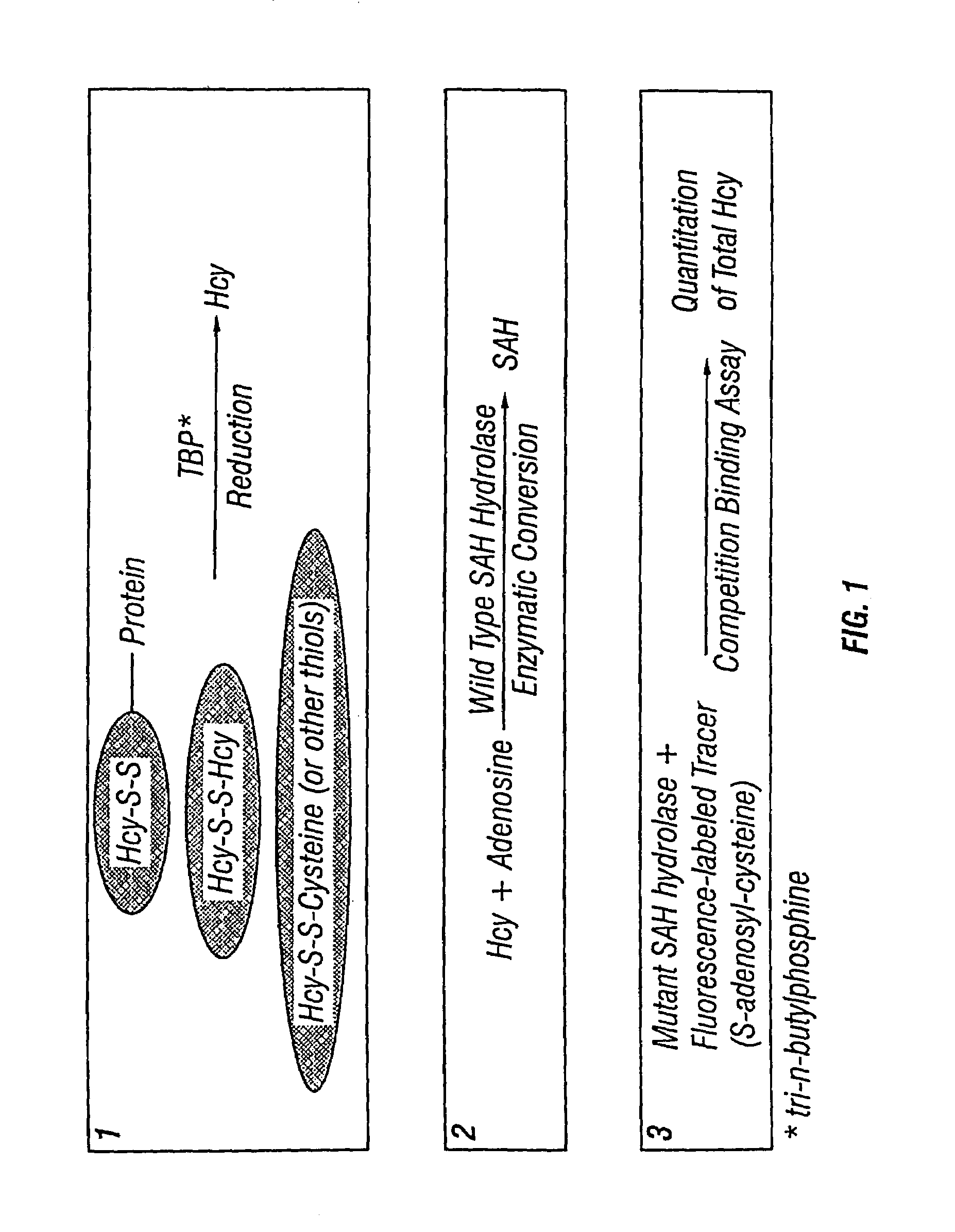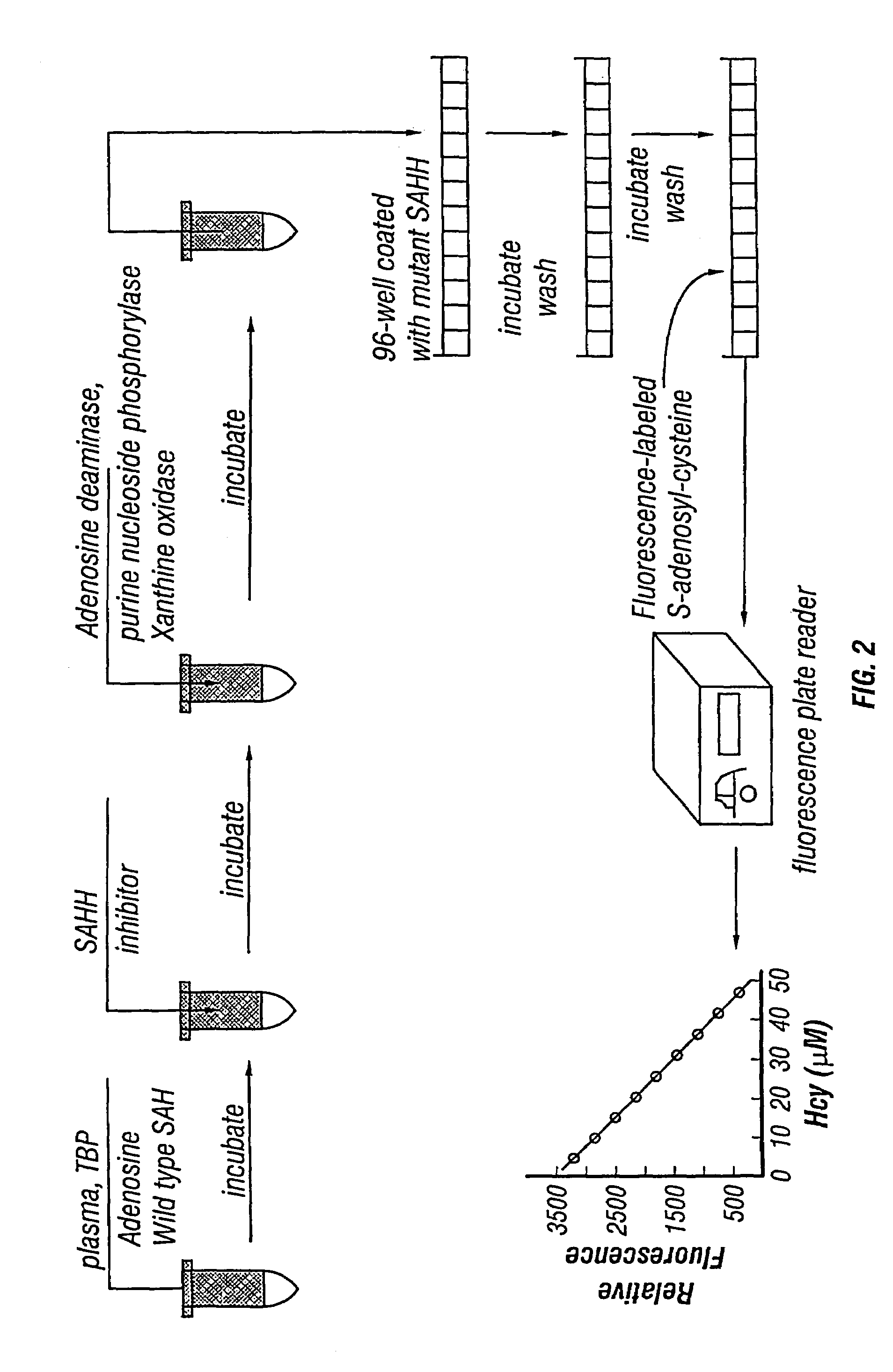Methods for assaying homocysteine
a technology of homocysteine and assay method, which is applied in the field of compositions and methods for assaying homocysteine, can solve the problems of chromatographic separation, time-consuming and cumbersome, and myocardial infarction, and achieve significant benefits, increase the sensitivity of assay, and significant benefits
- Summary
- Abstract
- Description
- Claims
- Application Information
AI Technical Summary
Benefits of technology
Problems solved by technology
Method used
Image
Examples
example 1
Preparation of Mutant SAH Hydrolase-Encoding Nucleic Acid
[0143]Human placental SAH hydrolase gene (SEQ ID No. 1) was subcloned into an expression vector pKK223-3 (Pharmacia Biotech, Piscataway, N.J.) at the EcoR I site. pKK223-3 contains the strong tac promoter upstream from the multiple cloning site and the strong rrnB ribosomal terminator downstream for control of protein expression. The SAH hydrolase gene-containing expression vector was transferred into an E. coli strain JM109 (Invitrogen, Carlsbad, Calif.). Site-directed mutagenesis of SAH hydrolase was conducted in two ways: 1) single-strand DNA-based M13 method; and 2) double-strand DNA-based PCR method.
[0144]Single-Strand DNA-Based Mutagenesis
[0145]Single-strand DNA-based mutagenesis was conducted based on the method described by Taylor, et al., Nucleic Acids Res., 13:8765–8785 (1985), which exploits the inability of NciI to cleave a thio-containing DNA strand. Sculptor™ invitro mutagenesis system RPN1526 (Amersham Life scie...
example 2
Large Scale Overexpression and Purification of Wild Type and Mutant Forms of SAH Hydrolases
[0168]Purification
[0169]The cell-free extract of IPTG-induced E. Coli JM109 (containing SAH hydrolase gene in pKK223-3 vector) culture was mixed with powder DEAE-cellulose (Sigma, St. Louis, Mo.) equilibrated with 0.1 M sodium phosphate buffer, pH 7.2 containing 1 mM EDTA (buffer A). The cell-free extract and DEAC-cellulose mixture was placed in a funnel and filtrated under vacuum. After washing with 3 volumes of buffer A, the filtrate was precipitated by solid ammonium sulfate (30–60%). The precipitated protein was collected by centrifugation at 13000 rpm, and resuspended in 50 mM sodium phosphate buffer, pH 7.2, containing 1 mM EDTA. The protein was chromatographed through a Sephacryl S-300 size exclusion column (2.5×100 cm) (Pharmacial Biotech, Piscataway, N.J.) followed by a DEAE-Sepharose ion exchange column (2.5×30 cm) eluted by a linear NaCl gradient. The major protein peak from DEAE-Se...
example 3
[0176]Preparation of Reagents
[0177]Preparation of Fluorophore-Labeled Ado and SAH Analogs
[0178]Method 1
[0179]Ado-5′-carboxylic acid (Sigma, St. Louis, Mo.) was derivatized with 9-(hydroxylmethyl)anthracene (HMA) (Fluka, Buchs, Switzerland). To 10 mg of Ado-5′-carboxylic acid dissolved in 100 ml of chloroform (10 min sonication) was added 50 mg 1-hydroxybenzotriazole (HOBT) (Janssen Chimica, Beerse, Belgium). After evaporation to dryness under nitrogen, 300 mg of N-ethyl-N′-(3-dimethylaminopropyl)carbodiimide hydrochloride in 300 ml chloroform and 5 ml of triethylamine were added. The resulting solution was kept at 0° C. for 30 min. To the above reaction mixture was added 200 mg HMA in 100 ml of chloroform. The mixture was allowed to stand at room temperature for 10 min. and then evaporated to dryness under a stream of nitrogen. The residue obtained was dissolved in 10 ml of HPLC mobile phase (methanol-water mixture, 90:10, w / w). One ml of the above solution was injected into a semi-...
PUM
| Property | Measurement | Unit |
|---|---|---|
| pH | aaaaa | aaaaa |
| pH | aaaaa | aaaaa |
| temperature | aaaaa | aaaaa |
Abstract
Description
Claims
Application Information
 Login to View More
Login to View More - R&D
- Intellectual Property
- Life Sciences
- Materials
- Tech Scout
- Unparalleled Data Quality
- Higher Quality Content
- 60% Fewer Hallucinations
Browse by: Latest US Patents, China's latest patents, Technical Efficacy Thesaurus, Application Domain, Technology Topic, Popular Technical Reports.
© 2025 PatSnap. All rights reserved.Legal|Privacy policy|Modern Slavery Act Transparency Statement|Sitemap|About US| Contact US: help@patsnap.com



